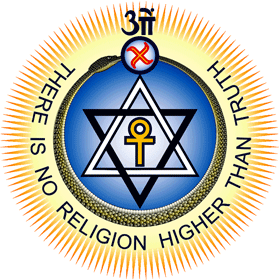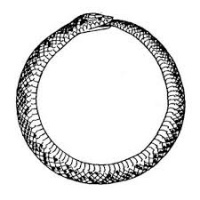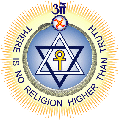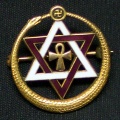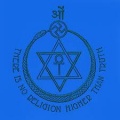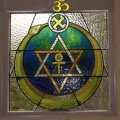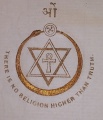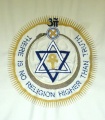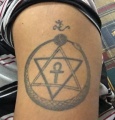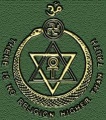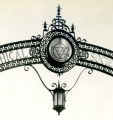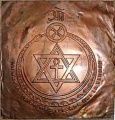Theosophical Seal: Difference between revisions
Pablo Sender (talk | contribs) No edit summary |
|||
| (26 intermediate revisions by 4 users not shown) | |||
| Line 1: | Line 1: | ||
'''The seal or emblem''' of the [[Theosophical Society]] consists of | [[File:TS-Seal.gif|right|300px|right|Seal of the Theosophical Society]] | ||
'''The seal or emblem''' of the [[Theosophical Society]] consists of several elements that represent a unity of meaning. It combines symbols drawn from various religious traditions around the world to express the order of the universe and the spiritual unity of all life. These symbols are: the [[Om]], the [[Swastika]], the [[Ouroboros]], the [[Star of David]], the [[Ankh]], and the [[Motto]] of the [[Theosophical Society]]. | |||
==The Sacred Word== | ==The Sacred Word== | ||
[[File:Om.gif|300px|right|thumb|Om symbol]] | |||
At the top of the emblem is the Sanskrit word Om, a very sacred word in India, being used by Hindus, Buddhists, and others. It cannot be translated into English because it has symbolic rather than ordinary meaning. It is pronounced as a single syllable, | At the top of the emblem is the [[Saṃskṛta|Sanskrit]] word [[Om]], a very sacred word in India, being used by Hindus, Buddhists, and others. It cannot be translated into English because it has symbolic rather than ordinary meaning. It is pronounced as a single syllable, "om," but is written with three letters in Sanskrit: a, u, and m—au being the way Sanskrit writes the sound o. It is thus the ultimate Unity manifesting itself in a threefold way. It is the trinity, which is found not only in [[Christianity]], but in [[Hinduism]], [[Buddhism]], and indeed all over the globe in many religions. | ||
As a Sacred Word, Om is like the Greek term Logos, adopted by the early Christians to symbolize the divine order manifested in the universe: “In the beginning was the Word, and the Word was with God, and the Word was God.” It is the word that creates, sustains, and transforms the whole cosmos: the word eternally spoken by God. | As a Sacred Word, Om is like the Greek term [[Logos]], adopted by the early Christians to symbolize the divine order manifested in the universe: “In the beginning was the Word, and the Word was with God, and the Word was God.” It is the word that creates, sustains, and transforms the whole cosmos: the word eternally spoken by God. | ||
Even the shape of the Sanskrit letters is interesting symbolically. What looks like a “3” connected to what looks like the Greek letter pi is the Sanskrit letter a, which is thus written in two dimensions. The small curved line over the pi-like part of the letter a is the letter u, which is one dimensional. And the small dot is the letter m, having no dimensions. As the letters of the word Om progress from one to the next, they become smaller in dimensions, finally ending with the primal point, the singularity from which the whole universe expands at the time of the Big Bang. | Even the shape of the Sanskrit letters is interesting symbolically. What looks like a “3” connected to what looks like the Greek letter pi is the Sanskrit letter a, which is thus written in two dimensions. The small curved line over the pi-like part of the letter a is the letter u, which is one dimensional. And the small dot is the letter m, having no dimensions. As the letters of the word Om progress from one to the next, they become smaller in dimensions, finally ending with the primal point, the singularity from which the whole universe expands at the time of the Big Bang. | ||
The Om is at the top of the seal because it symbolizes the Absolute expressing itself as the three-in-one divine intelligence or Logos from which the universe emanates and to which, at the end of time, it returns. The great Hindu devotional work, the Bhagavad Gita, says that the word Om should begin everything, because it symbolizes the divine origin of all things. | The Om is at the top of the seal because it symbolizes the Absolute expressing itself as the three-in-one divine intelligence or Logos from which the universe emanates and to which, at the end of time, it returns. The great Hindu devotional work, the [[Bhagavad Gita]], says that the word Om should begin everything, because it symbolizes the divine origin of all things. | ||
==The Whirling Cross== | ==The Whirling Cross== | ||
[[File:Swastika.gif|300px|right|thumb|Whirling cross or swastika]] | |||
Below the word Om is a whirling cross within a circle. It is a very ancient symbol, found all over the world—in India, among American Indians, and in many other cultures around the globe. In Sanskrit it is called a swastika, meaning “good.” It comes from the word swasti “welfare,” in turn from su “well” and asti “it is.” In popular use in India, it is thought to be a sign of good luck | Below the word Om is a whirling cross within a circle. It is a very ancient symbol, found all over the world—in India, among American Indians, and in many other cultures around the globe. In Sanskrit it is called a [[swastika]], meaning “good.” It comes from the word swasti “welfare,” in turn from su “well” and asti “it is.” In popular use in India, it is thought to be a sign of good luck. | ||
All crosses symbolize some aspect of manifestation. The swastika is a whirling cross, its clockwise (righthanded, sunwise, or deasil) motion suggesting the dynamic forces of creation. So the swastika represents the great process of becoming, which produces the world in which we live. It symbolizes what astrophysicists call the expansion of the universe. When the swastika is represented as turning in the opposite direction (that of the Nazi Hakenkreuz), it symbolizes the forces of contraction or destruction that bring about the end of a world when it has completed its evolution. The reverse turning swastika is not evil, but merely a symbol of the winding up of creative energies and of the process of coming to an end. | All crosses symbolize some aspect of manifestation. The swastika is a whirling cross, its clockwise (righthanded, sunwise, or deasil) motion suggesting the dynamic forces of creation. So the swastika represents the great process of becoming, which produces the world in which we live. It symbolizes what astrophysicists call the expansion of the universe. When the swastika is represented as turning in the opposite direction (that of the Nazi Hakenkreuz), it symbolizes the forces of contraction or destruction that bring about the end of a world when it has completed its evolution. The reverse turning swastika is not evil, but merely a symbol of the winding up of creative energies and of the process of coming to an end. | ||
The circle that encloses the swastika is what is called the | The circle that encloses the swastika is what is called the “[[Ring Pass-Not|ring-pass-not]],” that is, the boundary around our universe and within which the creative forces constantly swirl and evolve life. The center of the whirling swastika, however, is still. When we are there, we are, as T. S. Eliot said in Burnt Norton, “at the still point of the turning world.” It is the point of calmness and peace in the midst of the constantly changing world all around us. | ||
The encircled swastika, symbolizing the world in its dynamic aspect of becoming, is just below the Om symbol, which represents the eternal and absolute from which the world emanates. Their arrangement in the seal is therefore meaningful. This changing world depends on or hangs from the unchanging absolute. Moreover, the rest of the seal, which represents particular aspects of this evolving world, expands from the encircled swastika. The rest of the seal gives us, as it were, a closer look at the process symbolized by the whirling cross, the process going on within it. | The encircled swastika, symbolizing the world in its dynamic aspect of becoming, is just below the Om symbol, which represents the eternal and absolute from which the world emanates. Their arrangement in the seal is therefore meaningful. This changing world depends on or hangs from the unchanging absolute. Moreover, the rest of the seal, which represents particular aspects of this evolving world, expands from the encircled swastika. The rest of the seal gives us, as it were, a closer look at the process symbolized by the whirling cross, the process going on within it. | ||
==The Ouroboros== | ==The Ouroboros== | ||
[[File:Ouroboros.jpg|200px|right|thumb|Ouroboros]] | |||
Immediately connected with the whirling cross is a serpent swallowing its own tail. This symbol was called by the ancient Greek Gnostics and alchemists ouroboros. The circle it forms is a restatement of the circle around the swastika, representing the boundary of the universe, and the fact that it passes through the encircled swastika suggests that the serpent and everything it encircles are part of the creative energy of the whirling cross. | Immediately connected with the whirling cross is a serpent swallowing its own tail. This symbol was called by the ancient Greek Gnostics and alchemists [[Ouroboros|ouroboros]]. The circle it forms is a restatement of the circle around the swastika, representing the boundary of the universe, and the fact that it passes through the encircled swastika suggests that the serpent and everything it encircles are part of the creative energy of the whirling cross. | ||
The serpent swallowing its tail also represents the cycles of nature, the bounded eternity of the world, and the infinite order of life. One of the ideas it suggests is that which T. S. Eliot expressed in his poem East Coker: “In my beginning is my end,” that is, law and orderliness are to be found everywhere in the universe and in human life, so the end of everything is implicit in its beginning. | The serpent swallowing its tail also represents the cycles of nature, the bounded eternity of the world, and the infinite order of life. One of the ideas it suggests is that which T. S. Eliot expressed in his poem East Coker: “In my beginning is my end,” that is, law and orderliness are to be found everywhere in the universe and in human life, so the end of everything is implicit in its beginning. | ||
In the West, the serpent or the dragon is sometimes interpreted as a symbol of evil or temptation, but in the East, it is generally a symbol of wisdom, longevity, and happiness. In China, the dragon or winged serpent is a very favorable figure. In the Hindu tradition, the nagas or serpents are guardians of the good, and holy men are called | In the West, the serpent or the dragon is sometimes interpreted as a symbol of evil or temptation, but in the East, it is generally a symbol of wisdom, longevity, and happiness. In China, the dragon or winged serpent is a very favorable figure. In the Hindu tradition, the nagas or serpents are guardians of the good, and holy men are called “[[Naga|nagas]].” Even in the West, the serpent is associated with wisdom; Christ advised his followers to be “wise as serpents, and harmless as doves.” | ||
The serpent is also a symbol of healing, that is, of wholeness. Moses cured the sick among the Children of Israel in the desert by having them gaze upon a fiery serpent set upon a pole. Christian Church fathers interpreted that serpent as a type or anticipatory symbol of Christ on the cross. And one or two serpents intertwining a staff are even today a symbol of the healing professions. The fact that the serpent sheds its skin each year makes it an emblem of the cyclical process of the world and of the renewal of life, that is, of resurrection. And so in that way again the serpent is an analog of Christ and of the transformative process we will all pass through. | The serpent is also a symbol of healing, that is, of wholeness. Moses cured the sick among the Children of Israel in the desert by having them gaze upon a fiery serpent set upon a pole. Christian Church fathers interpreted that serpent as a type or anticipatory symbol of Christ on the cross. And one or two serpents intertwining a staff are even today a symbol of the healing professions. The fact that the serpent sheds its skin each year makes it an emblem of the cyclical process of the world and of the renewal of life, that is, of resurrection. And so in that way again the serpent is an analog of Christ and of the transformative process we will all pass through. | ||
==The Two Triangles== | ==The Two Triangles== | ||
[[File:Triangles.gif|300px|right|thumb|Two triangles]] | |||
The area inside the serpent’s circle represents the whole universe and everything in it. In colored versions of the seal, it is usually blue, passing from a light sky or baby blue at the top to a dark, almost navy blue at the bottom. That blue represents the cosmic sky, not just the physical sky we see, but the whole range of material substance in the universe, from rarefied, subtle matter at the “top” of the universe to gross, dense matter at the “bottom.” This colored background is not really a part of the seal, but it lends its own meaning to the whole symbol, as do the various other colors used in some versions of the seal. | The area inside the serpent’s circle represents the whole universe and everything in it. In colored versions of the seal, it is usually blue, passing from a light sky or baby blue at the top to a dark, almost navy blue at the bottom. That blue represents the cosmic sky, not just the physical sky we see, but the whole range of material substance in the universe, from rarefied, subtle matter at the “top” of the universe to gross, dense matter at the “bottom.” This colored background is not really a part of the seal, but it lends its own meaning to the whole symbol, as do the various other colors used in some versions of the seal. | ||
Upon that background of the universe are two interlaced triangles, another worldwide symbol. The hexagram or six-pointed star that they form is universal and has many meanings. It is found in Judaism as the Seal of Solomon or the Shield of David (magen david), but the symbol is also found in India, among the Gnostics and alchemists, and elsewhere around the world. | Upon that background of the universe are two interlaced triangles, another worldwide symbol. The hexagram or six-pointed star that they form is universal and has many meanings. It is found in Judaism as the Seal of Solomon or the [[Star of David|Shield of David]] (magen david), but the symbol is also found in India, among the Gnostics and alchemists, and elsewhere around the world. | ||
The upward-pointing triangle, which is light in color, symbolizes spirit or consciousness. The downward-pointing triangle, which is dark in color, symbolizes matter or substance. The fact that the two triangles are interlaced is a statement of the interdependence of spirit and matter. It is a basic Theosophical concept that every particle of matter has consciousness in it and that every spark of consciousness functions through a material form. Matter and spirit are mutually dependent. Neither can exist without the other. | The upward-pointing triangle, which is light in color, symbolizes [[spirit]] or [[consciousness]]. The downward-pointing triangle, which is dark in color, symbolizes [[matter]] or substance. The fact that the two triangles are interlaced is a statement of the interdependence of spirit and matter. It is a basic Theosophical concept that every particle of matter has consciousness in it and that every spark of consciousness functions through a material form. Matter and spirit are mutually dependent. Neither can exist without the other. | ||
The idea that matter and spirit are the two sides of one coin is reflected also in traditional Christian theology. It holds that at the end of time there will be a “general resurrection,” when all dead bodies will be brought to life and united with the souls from which they were separated at the moment of death. So in eternity, Christian theology says, our souls and bodies will again be conjoined, just as they now are. The inner meaning of the Christian doctrine of the last, general resurrection is the same as the Theosophical teaching of the mutual coexistence of matter and spirit. Reality is a whole, a unity expressing itself as both spirit and matter while remaining essentially One. That fact is expressed by the interlaced triangles, which, although two, form an interrelated whole just as spirit and matter or consciousness and substance do. | The idea that matter and spirit are the two sides of one coin is reflected also in traditional Christian theology. It holds that at the end of time there will be a “general resurrection,” when all dead bodies will be brought to life and united with the souls from which they were separated at the moment of death. So in eternity, Christian theology says, our souls and bodies will again be conjoined, just as they now are. The inner meaning of the Christian doctrine of the last, general resurrection is the same as the Theosophical teaching of the mutual coexistence of matter and spirit. Reality is a whole, a unity expressing itself as both spirit and matter while remaining essentially One. That fact is expressed by the interlaced triangles, which, although two, form an interrelated whole just as spirit and matter or consciousness and substance do. | ||
It is significant that triangles rather than some other geometrical shape are used to symbolize spirit and matter. Spirit and matter are both threefold in their natures. Spirit or consciousness has three aspects: the reality of being, awareness of others, and joyful activity. In Hinduism those are called sat (being), chit (awareness), and ananda (bliss), three terms often run together as sat-chit-ananda | It is significant that triangles rather than some other geometrical shape are used to symbolize spirit and matter. Spirit and matter are both threefold in their natures. Spirit or consciousness has three aspects: the reality of being, awareness of others, and joyful activity. In Hinduism those are called sat (being), chit (awareness), and ananda (bliss), three terms often run together as sat-chit-ananda to symbolize the unity of these three aspects. In Platonic philosophy they are called the Good, the Beautiful, and the True. In Freemasonry they are called Wisdom, Strength, and Beauty. In Christianity they correspond to the three divine Persons: Father, Son, and Holy Ghost, and to the three supernatural virtues: faith, hope, and love. | ||
Matter likewise has three aspects: stability, activity, and regularity. In Hinduism they are spoken of as three “strands” (gunas) out of which matter is woven: tamas or inertia, rajas or activity, and sattva or harmony. They correspond to the three alchemical elements of salt, mercury, and sulfur, and are represented by the three colors black, red, and white (or dark, bright, and light), which are the basic colors found all over the world. | Matter likewise has three aspects: stability, activity, and regularity. In Hinduism they are spoken of as three “strands” (gunas) out of which matter is woven: tamas or inertia, rajas or activity, and sattva or harmony. They correspond to the three alchemical elements of salt, mercury, and sulfur, and are represented by the three colors black, red, and white (or dark, bright, and light), which are the basic colors found all over the world. | ||
| Line 52: | Line 53: | ||
==The Ankh== | ==The Ankh== | ||
[[File:Ankh.gif|300px|right|thumb|Anhk symbol]] | |||
At the center of the six-pointed star of spirit and matter is the Egyptian cross or ankh, symbolic of life. The six points of the triangles and the ankh at the center represent the seven principles of the universe. Or, if we think of the hexagram as having twelve sides or twelve points (six outward and six inward), the center is the thirteenth element, corresponding to Christ among the apostles, Hercules in his labors, and so on. The ankh also represents the idea that life results from the interaction of spirit or consciousness (the upward triangle) and matter or substance (the downward triangle). | At the center of the six-pointed star of spirit and matter is the Egyptian cross or ankh, symbolic of life. The six points of the triangles and the ankh at the center represent the seven principles of the universe. Or, if we think of the hexagram as having twelve sides or twelve points (six outward and six inward), the center is the thirteenth element, corresponding to Christ among the apostles, Hercules in his labors, and so on. The ankh also represents the idea that life results from the interaction of spirit or consciousness (the upward triangle) and matter or substance (the downward triangle). | ||
| Line 63: | Line 65: | ||
==The Motto== | ==The Motto== | ||
Around the bottom of the serpent is a motto: “There is no religion higher than truth.” It is an English translation of a Sanskrit motto, one word of which has special meanings that shed light on the whole motto. The original Sanskrit is Satyan nasti paro dharmah, which might also be translated as “Nothing is greater than truth.” The first three words can be literally translated thus: satyan “than truth,” nasti “is not,” paro “further, greater, higher.” Dharmah is difficult to translate because it means so many things. Its root meaning is “what is established or firm.” And from that basic root sense radiate such other meanings as “law,” “customs,” “duty,” “morality,” “justice,” “religion,” “teachings or doctrine,” “good works,” and “essential nature.” | [[File:Sanskrit motto.png|250px|right|thumb|Motto of the Theosophical Society, in Sanskrit]] | ||
Around the bottom of the serpent is a [[Theosophical motto|motto]]: “There is no religion higher than truth.” It is an English translation of a Sanskrit motto, one word of which has special meanings that shed light on the whole motto. The original Sanskrit is Satyan nasti paro dharmah, which might also be translated as “Nothing is greater than truth.” The first three words can be literally translated thus: satyan “than truth,” nasti “is not,” paro “further, greater, higher.” Dharmah is difficult to translate because it means so many things. Its root meaning is “what is established or firm.” And from that basic root sense radiate such other meanings as “law,” “customs,” “duty,” “morality,” “justice,” “religion,” “teachings or doctrine,” “good works,” and “essential nature.” | |||
The motto is not specifically about what we think of as religion. Instead it is saying that none of our commitments or social conventions or ideas can measure up to the reality of what truly is. Reality is greater than any of its parts and is beyond all our notions about it. In saying that, the motto at the bottom of the seal directs our attention back to the word Om at the top. That word is a symbol of what truly is, of Truth. And so the whole seal, just like the serpent, ends where it began—affirming the supreme Truth that unites all things. | The motto is not specifically about what we think of as religion. Instead it is saying that none of our commitments or social conventions or ideas can measure up to the reality of what truly is. Reality is greater than any of its parts and is beyond all our notions about it. In saying that, the motto at the bottom of the seal directs our attention back to the word Om at the top. That word is a symbol of what truly is, of Truth. And so the whole seal, just like the serpent, ends where it began—affirming the supreme Truth that unites all things. | ||
== | == Gallery == | ||
The Theosophical Society Seal has captured the imagination of numerous artists. It has been rendered in paintings, drawings, wood, plaster, computer graphics, cut paper, stained glass, jewelry, embroidery, bronze, zinc printing plates, a garden, and at least one tattoo. Here are a few examples: | |||
<gallery> | |||
File:Graphic design by Ruben Cabigting.gif|Graphic design by Ruben Cabigting | |||
File:Pin.jpg|Jewelry | |||
File:St Louis TS.jpg|St. Louis Lodge | |||
File:TS in Bolivia.jpg|Stained glass at TS in Bolivia | |||
File:Annie Besant letterhead.jpg|Annie Besant letterhead, 1891 | |||
File:Printing plate.jpg|Printing plate | |||
File:Embroidery by Soffy Murillo.jpg|Embroidery by Soffy Murillo | |||
File:TS seal in Bangalore.jpg|Garden at Bangalore Lodge | |||
File:Painted on post at YT event.jpg|Painted on a post by Young Theosophists | |||
File:Stained glass.jpg|Etched glass in doorway | |||
File:Tattoo.jpg|Tattoo | |||
File:Cut paper.jpg|Cut paper | |||
File:TS in Africa ZA.jpg|TS in Africa | |||
File:Embroidered in curtain.jpg|Embroidered curtain in Baltimore | |||
File:Arch by Claude Bragdon.jpg|In arch by Claude Bragdon | |||
File:Worked copper from Russia.jpg|Worked copper from Russia | |||
File:Door in Budpest.jpg|Door of TS in Budapest | |||
File:HPB Museum in Ukraine.jpg|HPB House-Museum in Ukraine | |||
</gallery> | |||
==Online resources== | |||
===Articles=== | |||
*[http://www.theosophical.org/files/resources/articles/Swastika.pdf# The Swastika] Anon. | |||
*[http://theosophy.katinkahesselink.net/radha-burnier/Religion-Truth.htm# There is no Religion Higher than Truth] by Radha Burnier | |||
*[http://www.katinkahesselink.net/his/TS-seal.htm# Early history of the Theosophical Seal] by Katinka Hesselink | *[http://www.katinkahesselink.net/his/TS-seal.htm# Early history of the Theosophical Seal] by Katinka Hesselink | ||
*[http://www.universaltheosophy.com/articles/wqj/theosophical-symbolism/ Theosophical Symbolism] by William Quan Judge, posted on Universal Theosophy website. Originally published in ''The Path'', May, 1886. | |||
* [https://www.theosophy.world/encyclopedia/theosophical-society-emblem Theosophical Society, Emblem of the] at Theosophy World. | |||
===Books=== | |||
*[http://www.theosophical.org/files/resources/books/Seal/TheosophicalSeal.pdf# The Theosophical Seal] by Arthur M. Coon | |||
== Notes == | |||
<references/> | |||
[[Category: | [[Category:Symbols]] | ||
[[it:Emblema della Società Teosofica]] | |||
Latest revision as of 14:09, 5 September 2024
The seal or emblem of the Theosophical Society consists of several elements that represent a unity of meaning. It combines symbols drawn from various religious traditions around the world to express the order of the universe and the spiritual unity of all life. These symbols are: the Om, the Swastika, the Ouroboros, the Star of David, the Ankh, and the Motto of the Theosophical Society.
The Sacred Word
At the top of the emblem is the Sanskrit word Om, a very sacred word in India, being used by Hindus, Buddhists, and others. It cannot be translated into English because it has symbolic rather than ordinary meaning. It is pronounced as a single syllable, "om," but is written with three letters in Sanskrit: a, u, and m—au being the way Sanskrit writes the sound o. It is thus the ultimate Unity manifesting itself in a threefold way. It is the trinity, which is found not only in Christianity, but in Hinduism, Buddhism, and indeed all over the globe in many religions.
As a Sacred Word, Om is like the Greek term Logos, adopted by the early Christians to symbolize the divine order manifested in the universe: “In the beginning was the Word, and the Word was with God, and the Word was God.” It is the word that creates, sustains, and transforms the whole cosmos: the word eternally spoken by God.
Even the shape of the Sanskrit letters is interesting symbolically. What looks like a “3” connected to what looks like the Greek letter pi is the Sanskrit letter a, which is thus written in two dimensions. The small curved line over the pi-like part of the letter a is the letter u, which is one dimensional. And the small dot is the letter m, having no dimensions. As the letters of the word Om progress from one to the next, they become smaller in dimensions, finally ending with the primal point, the singularity from which the whole universe expands at the time of the Big Bang.
The Om is at the top of the seal because it symbolizes the Absolute expressing itself as the three-in-one divine intelligence or Logos from which the universe emanates and to which, at the end of time, it returns. The great Hindu devotional work, the Bhagavad Gita, says that the word Om should begin everything, because it symbolizes the divine origin of all things.
The Whirling Cross
Below the word Om is a whirling cross within a circle. It is a very ancient symbol, found all over the world—in India, among American Indians, and in many other cultures around the globe. In Sanskrit it is called a swastika, meaning “good.” It comes from the word swasti “welfare,” in turn from su “well” and asti “it is.” In popular use in India, it is thought to be a sign of good luck.
All crosses symbolize some aspect of manifestation. The swastika is a whirling cross, its clockwise (righthanded, sunwise, or deasil) motion suggesting the dynamic forces of creation. So the swastika represents the great process of becoming, which produces the world in which we live. It symbolizes what astrophysicists call the expansion of the universe. When the swastika is represented as turning in the opposite direction (that of the Nazi Hakenkreuz), it symbolizes the forces of contraction or destruction that bring about the end of a world when it has completed its evolution. The reverse turning swastika is not evil, but merely a symbol of the winding up of creative energies and of the process of coming to an end.
The circle that encloses the swastika is what is called the “ring-pass-not,” that is, the boundary around our universe and within which the creative forces constantly swirl and evolve life. The center of the whirling swastika, however, is still. When we are there, we are, as T. S. Eliot said in Burnt Norton, “at the still point of the turning world.” It is the point of calmness and peace in the midst of the constantly changing world all around us.
The encircled swastika, symbolizing the world in its dynamic aspect of becoming, is just below the Om symbol, which represents the eternal and absolute from which the world emanates. Their arrangement in the seal is therefore meaningful. This changing world depends on or hangs from the unchanging absolute. Moreover, the rest of the seal, which represents particular aspects of this evolving world, expands from the encircled swastika. The rest of the seal gives us, as it were, a closer look at the process symbolized by the whirling cross, the process going on within it.
The Ouroboros
Immediately connected with the whirling cross is a serpent swallowing its own tail. This symbol was called by the ancient Greek Gnostics and alchemists ouroboros. The circle it forms is a restatement of the circle around the swastika, representing the boundary of the universe, and the fact that it passes through the encircled swastika suggests that the serpent and everything it encircles are part of the creative energy of the whirling cross.
The serpent swallowing its tail also represents the cycles of nature, the bounded eternity of the world, and the infinite order of life. One of the ideas it suggests is that which T. S. Eliot expressed in his poem East Coker: “In my beginning is my end,” that is, law and orderliness are to be found everywhere in the universe and in human life, so the end of everything is implicit in its beginning.
In the West, the serpent or the dragon is sometimes interpreted as a symbol of evil or temptation, but in the East, it is generally a symbol of wisdom, longevity, and happiness. In China, the dragon or winged serpent is a very favorable figure. In the Hindu tradition, the nagas or serpents are guardians of the good, and holy men are called “nagas.” Even in the West, the serpent is associated with wisdom; Christ advised his followers to be “wise as serpents, and harmless as doves.”
The serpent is also a symbol of healing, that is, of wholeness. Moses cured the sick among the Children of Israel in the desert by having them gaze upon a fiery serpent set upon a pole. Christian Church fathers interpreted that serpent as a type or anticipatory symbol of Christ on the cross. And one or two serpents intertwining a staff are even today a symbol of the healing professions. The fact that the serpent sheds its skin each year makes it an emblem of the cyclical process of the world and of the renewal of life, that is, of resurrection. And so in that way again the serpent is an analog of Christ and of the transformative process we will all pass through.
The Two Triangles
The area inside the serpent’s circle represents the whole universe and everything in it. In colored versions of the seal, it is usually blue, passing from a light sky or baby blue at the top to a dark, almost navy blue at the bottom. That blue represents the cosmic sky, not just the physical sky we see, but the whole range of material substance in the universe, from rarefied, subtle matter at the “top” of the universe to gross, dense matter at the “bottom.” This colored background is not really a part of the seal, but it lends its own meaning to the whole symbol, as do the various other colors used in some versions of the seal.
Upon that background of the universe are two interlaced triangles, another worldwide symbol. The hexagram or six-pointed star that they form is universal and has many meanings. It is found in Judaism as the Seal of Solomon or the Shield of David (magen david), but the symbol is also found in India, among the Gnostics and alchemists, and elsewhere around the world.
The upward-pointing triangle, which is light in color, symbolizes spirit or consciousness. The downward-pointing triangle, which is dark in color, symbolizes matter or substance. The fact that the two triangles are interlaced is a statement of the interdependence of spirit and matter. It is a basic Theosophical concept that every particle of matter has consciousness in it and that every spark of consciousness functions through a material form. Matter and spirit are mutually dependent. Neither can exist without the other.
The idea that matter and spirit are the two sides of one coin is reflected also in traditional Christian theology. It holds that at the end of time there will be a “general resurrection,” when all dead bodies will be brought to life and united with the souls from which they were separated at the moment of death. So in eternity, Christian theology says, our souls and bodies will again be conjoined, just as they now are. The inner meaning of the Christian doctrine of the last, general resurrection is the same as the Theosophical teaching of the mutual coexistence of matter and spirit. Reality is a whole, a unity expressing itself as both spirit and matter while remaining essentially One. That fact is expressed by the interlaced triangles, which, although two, form an interrelated whole just as spirit and matter or consciousness and substance do.
It is significant that triangles rather than some other geometrical shape are used to symbolize spirit and matter. Spirit and matter are both threefold in their natures. Spirit or consciousness has three aspects: the reality of being, awareness of others, and joyful activity. In Hinduism those are called sat (being), chit (awareness), and ananda (bliss), three terms often run together as sat-chit-ananda to symbolize the unity of these three aspects. In Platonic philosophy they are called the Good, the Beautiful, and the True. In Freemasonry they are called Wisdom, Strength, and Beauty. In Christianity they correspond to the three divine Persons: Father, Son, and Holy Ghost, and to the three supernatural virtues: faith, hope, and love.
Matter likewise has three aspects: stability, activity, and regularity. In Hinduism they are spoken of as three “strands” (gunas) out of which matter is woven: tamas or inertia, rajas or activity, and sattva or harmony. They correspond to the three alchemical elements of salt, mercury, and sulfur, and are represented by the three colors black, red, and white (or dark, bright, and light), which are the basic colors found all over the world.
So it is not accidental that triangles are used to represent both spirit and matter. The three sides and three points of the two triangles total twelve, the number of the signs of the Zodiac, the Tribes of Israel, the apostles of Christ, the labors of Hercules, and a lot of other mythological and symbolic dozens. They all refer to the experiences we go through in this world.
The Ankh
At the center of the six-pointed star of spirit and matter is the Egyptian cross or ankh, symbolic of life. The six points of the triangles and the ankh at the center represent the seven principles of the universe. Or, if we think of the hexagram as having twelve sides or twelve points (six outward and six inward), the center is the thirteenth element, corresponding to Christ among the apostles, Hercules in his labors, and so on. The ankh also represents the idea that life results from the interaction of spirit or consciousness (the upward triangle) and matter or substance (the downward triangle).
The ankh is also called an “ansate” cross, that is, a cross “with a handle.” Human or divine figures in Egyptian art are often depicted as carrying the ankh by its loop or “handle.” When we are functioning in a fully human mode, with spirit and matter balanced, we have, as it were, a “handle” on life.
Since the ankh consists of a tau (or T) cross topped by a circle, it combines the meanings of the T-square and the circle. The T-square is an instrument used by draftsmen and architects to draw parallel lines (symbolically, to recognize parallelisms and analogies) and as a support for triangles in drawing angles (symbolically, for serving as the basis for all the triplicities of spirit and matter). Like all square forms, it also represents matter. The circle represents spirit. The T-square and circle combined are thus another representation of spirit and matter interacting and producing life by their interaction.
Thus the ankh repeats on a lower register the symbolism already expressed by the interlaced triangles, the serpent, and the encircled swastika. All of those elements speak of the mutual connections between spirit and matter as expressions of the divine source, symbolized by the crowning Om. The repetition, with variation in details, of the same symbolic meanings by these different elements is a statement of the correspondences that exist throughout the universe. The world finally is one and whole, it is coherent, and it is meaningful in all its parts. That is what the seal is also saying in its entirety.
The Motto
Around the bottom of the serpent is a motto: “There is no religion higher than truth.” It is an English translation of a Sanskrit motto, one word of which has special meanings that shed light on the whole motto. The original Sanskrit is Satyan nasti paro dharmah, which might also be translated as “Nothing is greater than truth.” The first three words can be literally translated thus: satyan “than truth,” nasti “is not,” paro “further, greater, higher.” Dharmah is difficult to translate because it means so many things. Its root meaning is “what is established or firm.” And from that basic root sense radiate such other meanings as “law,” “customs,” “duty,” “morality,” “justice,” “religion,” “teachings or doctrine,” “good works,” and “essential nature.”
The motto is not specifically about what we think of as religion. Instead it is saying that none of our commitments or social conventions or ideas can measure up to the reality of what truly is. Reality is greater than any of its parts and is beyond all our notions about it. In saying that, the motto at the bottom of the seal directs our attention back to the word Om at the top. That word is a symbol of what truly is, of Truth. And so the whole seal, just like the serpent, ends where it began—affirming the supreme Truth that unites all things.
Gallery
The Theosophical Society Seal has captured the imagination of numerous artists. It has been rendered in paintings, drawings, wood, plaster, computer graphics, cut paper, stained glass, jewelry, embroidery, bronze, zinc printing plates, a garden, and at least one tattoo. Here are a few examples:
Online resources
Articles
- The Swastika Anon.
- There is no Religion Higher than Truth by Radha Burnier
- Early history of the Theosophical Seal by Katinka Hesselink
- Theosophical Symbolism by William Quan Judge, posted on Universal Theosophy website. Originally published in The Path, May, 1886.
- Theosophical Society, Emblem of the at Theosophy World.
Books
- The Theosophical Seal by Arthur M. Coon
